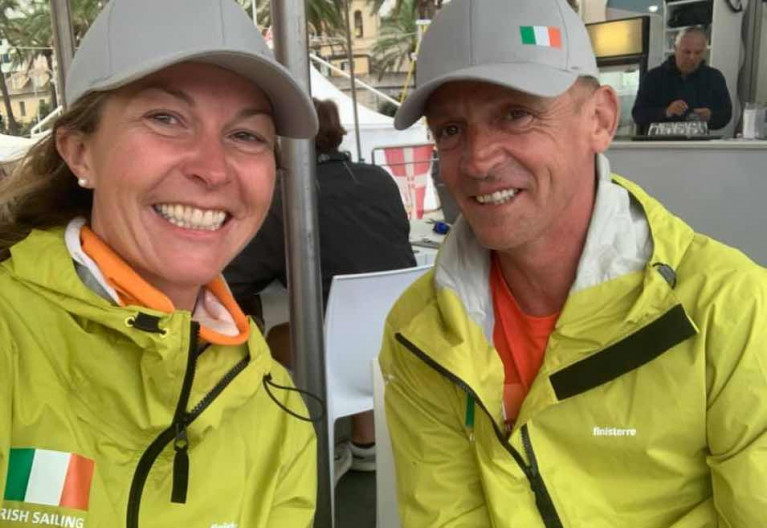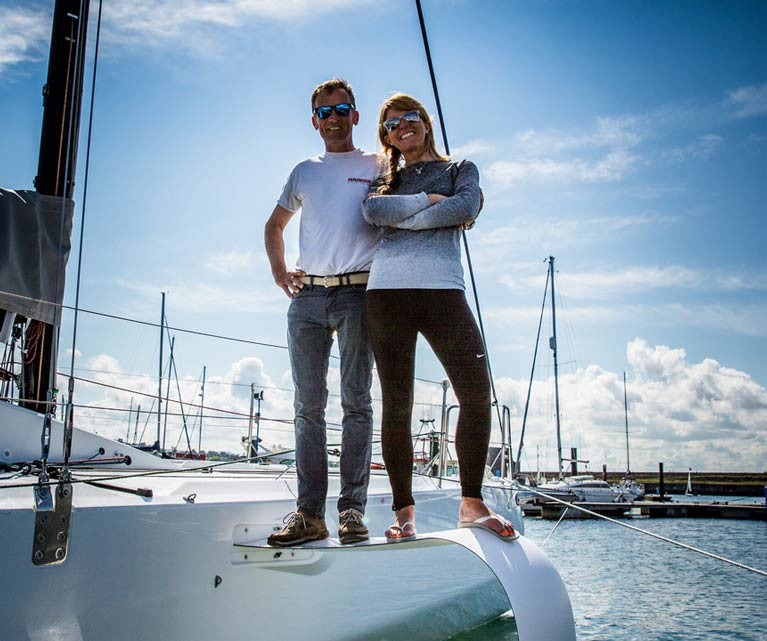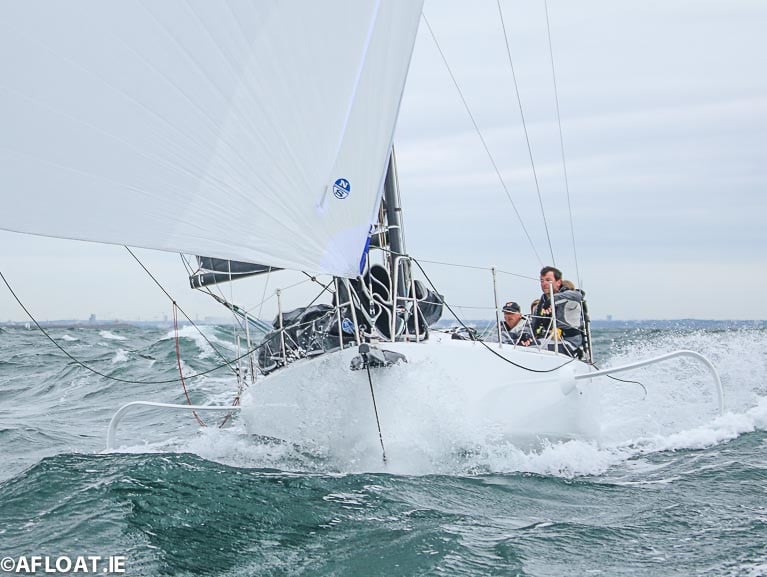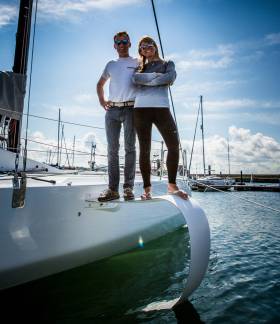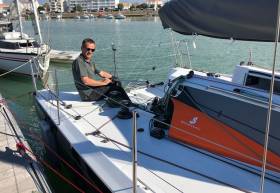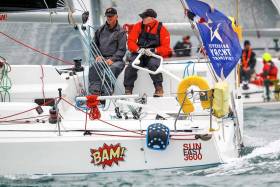Displaying items by tag: Conor Fogerty
There will be only 33 starters in the second leg of La Solitaire du Figraro on Sunday as injured Irish solo sailor Conor Fogerty of Howth withdraws.
Following his leg injury sustained during the final night of Stage 1, Fogerty (Immunex365.co.uk) has taken the medical advice of the race medical experts and has officially withdrawn from the 53rd La Solitaire du Figaro.
The entrepreneur from Dublin, a very experienced crewed offshore racer who has taken part in many of the classic long offshore races over his long career, says he will take stock from here and consider what his next moves are with the Figaro Beneteau 3, which he owns.
This morning in Port-La-Forêt: Fogerty said “ It is a question of safety and that decision is largely out of my hands. So I am quite gutted. The class doctor says I am not fit enough to race. It is an expensive operation to come over and do La Solitaire and then not be able to complete it. My sponsorship does not cover all the costs, so it has cost me quite a lot of money. That is tough. This muscular lesion will not repair itself on time.”
He added: “I have learned a lot but am not used to being down the back of the fleet. But the Figaro is such a high level you have to immerse yourself in the culture in France and live it and breathe it 24/7 to even be in the middle of the fleet. So I will reflect on where I go from here. My original plan is to do the Caribbean 600 on the boat as I believe the boat is a reaching boat, and I would enjoy that course. So I will put a plan together to do the RORC Transatlantic and then the Caribbean 600 doublehanded. Next season on the Figaro? Well, I am feeling pretty low and ego bashed at the moment and where I am just now. I need to build myself back up again.”
Ireland is fielding three of the 34 solo skippers expected to compete in this summer’s 53rd La Solitaire du Figaro race in France.
The starting gun for the first stage of the 53rd edition of La Solitaire du Figaro will sound on August 21, off Saint-Michel-Chef-Chef in the Loire-Atlantique after the fleet has paraded up the Loire from Nantes.
And this year’s edition promises to be every bit as tough and challenging as usual. The three-stage course will cover an aggregate of 2000 nautical miles (3700kms) with 34 solo skippers set to take on the annual multi-stage solo race. The field includes five women and nine rookies.
 Conor Fogerty
Conor Fogerty
Among the International rookies is Howth's Conor Fogerty (51). The Dubliner's career-highs include the OSTAR (Gypsy Moth Trophy) in 2017, a transatlantic victory that earned him the Irish Sailor of the Year title.
 Tom Dolan
Tom Dolan
After just three editions, Tom Dolan (35) of County Meath, who scored a fifth overall, the best non-French result for more than 20 years, in 2020, has realistic hopes of finishing on the overall podium this season. Dolan's sailing highlights include 2021: 10th Elite Offshore Racing Championship, 2021: 4th stage of La Solitaire du Figaro, 2021: 5th Solo Guy Cotten, 2020: 6th Elite Offshore Racing Championship, 2020: 5th La Solitaire du Figaro, 2020: 1st ViVi Trophy La Solitaire du Figaro and of course in 2020: Irish Sailor of the Year.
 Kenny Rumball
Kenny Rumball
The third Irish skipper is Kenny Rumball (34) of Ireland's Offshore Racing Academy, who competes in his second Figaro. The Dun Laoghaire sailor's career highlights include a 2022 Round Ireland Class win on Darkwood J121
as well as fourth in the Volvo Cork Week 1720 Division. In 2021 Rumball was a Class Winner in the Dun Laoghaire to Dingle Race and also a class winner in Rolex Middle Sea Race in the same year.
Over the years, the Figaro event has remained the proving ground for emerging solo racers, the very top competitors often going on to success on the Vendée Globe, the demanding solo non-stop race around the world.
Since 2019 it has been raced on the Figaro Beneteau 3, a 36ft foil-assisted one design which means that the sailors compete on equal terms. It is the yearly pinnacle event on the Figaro circuit as well as the highlight of the French Elite Offshore Racing Championship.
Three main race stages
This year’s course comprises three long, tough stages all more than 635 miles in length. Starting from Nantes the stages stop in Royan and Port La -Forêt before finishing in Saint Nazaire. The focus is very much on the start port of Nantes and the finish into Saint Nazaire, key cities in the Loire-Atlantique region, which is a Major Partner of the race, complementing new main partner Paprec.
The Grand Depart takes place in Nantes on the 21st of August and the finish, the Grand Final, is some three weeks later in Saint Nazaire. Both the start and finish cities will offer popular exhibitions and festivals for visitors to enjoy in the respective race villages.
The 2022 course is summarised by Yann Chateau the new race director of La Solitaire du Figaro, who will be assisted this year by Pierre Hays, deputy race director:
“ La Solitaire du Figaro 2022 takes place in 3 stages in a format that will be hard on the bodies and minds of the sailors. Typically each will start on the Sunday for a theoretical finish of the boats on the following Thursday morning, And so the solo racers on this 53rd edition of the Solitaire will compete over long legs of four consecutive nights at sea. Success on this race is also always about the ability to recover between stages. They then will only have three nights ashore to sleep and prepare the boat before attacking the next stage. And so this Solitaire du Figaro is fully worthy of its reputation as hard, committed, challenging and very technical.
The first stage will begin with a parade in the Loire on Saturday, August 20, before a start the next day in the bay of Saint Michel-Chef-Chef. Stage 1 races from Nantes to Port-la-Forêt via Skokholm Island, a small island in the SW tip of Wales. This 644 mile long leg passes Lands End and the tip of Brittany, returning to finish in Port La Forêt. The second stage of 635 miles is more of a Channel leg from Port La Forêt to Eddystone off Cornwall and the Channel Islands before a Biscay finale across the legendary Bay to La Coruna back to finish in Saint Nazaire, more than 700 miles.”
Something new in this race is the integration of each stage of an intermediate sprint, a passage of a previously defined course mark (indicated in the notice of race). The first competitors to cross this mark will receive a time bonus towards general classification (5 minutes for the first / 3 minutes for the second / 1 minute for the third). This will be an opportunity to increase the stakes around these crossing points and to increase the tactical risk-taking during the last miles into these sprint marks. skipper, the last mile option.
A look at the Rookies and Internationals
The rookies who will participate for the first time in their sporting career in La Solitaire du Figaro are preparing to do battle up against some of the race’s biggest and most successful racers such as Fred Duthil who has 12 participations on the clock.
Typically the pathway to success on La Solitaire du Figaro usually sees podium positions on the stages progressively become overall podiums on the General Classification. A win in the Bizuth or Rookie division is often not just the first sign of emerging talent but it often is a passport to further sponsorship or commercial funding for the future. Among those who have been top rookies in the past are François Gabart in 2008, just four years before he went on to win the Vendée Globe at his first attempt.
Among the new talents, rookies on this edition are Basile Bourgnon, who is making a promising start to the 2022 season in Figaro (winner of the Drheam-Cup with Robin Follin, 2nd in the Solo rookie ranking on the Maitre CoQ, 5th at the end of the BPGO Trophy – On the Route des Îles du Ponant 2022 (with Yann Eliès), 1st Rookie, of the Le Havre Allmer Cup.) One of Bourgnon’s main rivals will be Chloé Le Bars (Région Bretagne-CMB Océane) who has already signed a 1st rookie place on the Solo Maître Coq.
Guillaume Pirouelle (Région Normandie), selected to join the "Skipper Normandie" system over three seasons in Figaro Bénéteau 3 has an impressive CV in the 470 and in youth sailing, He has a Youth World Champion title in 470, 2 World Vice-Champion titles in 420 and several European Champion titles in 420 and 470. He raced the Diam24 on several Tour Voile (formerly Tour de France à la Voile), including two podiums and a victory in 2019. Last year Pirouelle worked alongside Alexis Loison co-skipper on the two handed races but this year it is his turn to be alone aboard the Figaro Région Normandie. Also present will be Davy Beaudart (Nauty'mor), a yard manager and skipper, who is already well known in the world of offshore racing, often co-skipper of choice of Louis Burton. He has 12 victories in the Mini 6.50 Class between 2001 and 2018.
Laurent Bourguès (#Become a Partner),is well known as a preparateur and technician working with the likes of Yvan Bourgnon, Yves Le Blevec, Tanguy de Lamotte, Thomas Ruyant. He sets out on La Solitaire du Figaro for the first time. He will be one of the rookies to follow, as will Romen Richard, twice runner-up as Youth National Champion and French representative at the 2014 Youth Olympic Games in China.
Among the International rookies are Scotland’s Piers Copham (Voiles des Anges), or the German Susann Beucke (This race is female) a silver medalist in the 49er FX in 2020 at the Tokyo Olympics, a double European champion and numerous times in the top 5 of the World Championship. Then there is Irish skipper, Conor Fogerty.
In general, the Figaro racers are getting younger but this race sees the return of some ‘old hands’ like Jörg Riechers (Alva Yachts), who last took part in 2005. The German skipper, 2nd in the mini transat in 2017, 3rd in the Normandy Channel Race in class 40 two years later and 6th in the Transat Jacques Vabre has a new IMOCA in build for the next Vendée Globe and sees his return to La Solitaire du Figaro as a good way to sharpen up his racing skills this summer.
Among the top International skippers who are back to try and improve on their career-best results are Briton Alan Roberts who will start his ninth La Solitaire du Figaro looking to better his ninth overall in 2015 and 10th in 2020. Tom Dolan (Smurfit Kappa - Kingspan) cut his teeth in Mini 6.50 before joining the Figaro Bénéteau circuit. After just three editions, Dolan scored a fifth overall, the best non-French result for more than 20 years. Both Roberts and Dolan have realistic hopes of finishing on the overall podium this season. Both are recent holders of the VIVI Trophy for the top non-French finisher on the overall General Classification
French Claim European Mixed Offshore Title as Ireland's Fogerty & Glenny Make L30 Debut
France has claimed the inaugural European Mixed Offshore Title in Italy in which Ireland's Conor Fogerty and Susan Glenny made their debut in the L30 keelboat but unfortunately did not finish the one race event.
Fogerty says he is still 'licking his wounds' after the top-level event, claiming that 'only three hours sail time on the boat before the main event wasn't ideal'.
"We had issues onboard which augmented under pressure. I would have at least expected a fifth or sixth, but we were set on finding big holes in a light breeze", the Howth sailor related to Afloat.
 Conor Fogerty and Susan Glenny - the Irish pair say it was an amazing learning experience in a brand new boat and on a colourful race track that presented all of the favourite wind shut downs, complex currents and Mediterranean thermal affects
Conor Fogerty and Susan Glenny - the Irish pair say it was an amazing learning experience in a brand new boat and on a colourful race track that presented all of the favourite wind shut downs, complex currents and Mediterranean thermal affects
In the end, the race was a close and long duel between French team Benjamin Schwartz and Marie Riou against Íker Martínez & Natalia Via-Dufresne (ESP) with the French finally on top. "It was a hard and complicated race where we made some risky choices that turned out to be some bad ones and some good ones", so the first feedback of Benjamin Schwartz. The French took the lead from the Spanish team during the last night with a risky decision to sail away from the leading boat and the rest of the fleet. "In the morning we found ourselves at the top of the fleet from where we controlled the race for the last few miles back to Genoa“, explained Marie Riou.
Surprisingly, it wasn’t the Spanish team to cross the finishing line on second place after leading for many many hours. It was up to the Belgians Jonas Gerckens and Sophie Faguet to claim silver around 80 minutes after the French gold medalists. Third and with a slight bitter taste in their mouths, the Spanish Martínez/Via-Dufresne cut the line at 10:52 a.m., returning from a remarkable performance as they maintained the lead of the race until just a few hours before the finish and dictated the pace to the entire fleet for almost the entire course of the race. Just a few minutes after the Iberian crew, the national team Claudia Rossi and Matteo Mason finished a long race in pursuit of the first three. They tried and never gave up by sailing an excellent race, especially since they were making their debut on the L30.
 L30 Mixed Offshore European Entry List
L30 Mixed Offshore European Entry List
What's the L30 like offshore?
Fogerty says from his brief experience the L30 is an 'interesting concept, twin wheels, lifting rudders and keel, not to mention a possible configuration of Gennaker, J1, J3 and main all flying at the same time......'
 Fogerty & Glenny have expressed a hope to represent Ireland in the new mixed offshore keelboat class that will have its inaugural year as an Olympic class at the Paris 2024 Olympics
Fogerty & Glenny have expressed a hope to represent Ireland in the new mixed offshore keelboat class that will have its inaugural year as an Olympic class at the Paris 2024 Olympics
The former Ostar winner says he has some misgivings with the L30 as an offshore boat, "Any one design is going to be fun, and the L30 ticks that box, but Offshore? Shorthanded? It's too busy for a 30-ft and not set up for shorthanded racing, the twin wheel configuration cuts you off from the tools to trim your sails, even the autopilot is 10ft away on the coach roof. I also wouldn't be happy in a big breeze, due all those retractable underwater foils"
 The L30 - a fun boat
The L30 - a fun boat
He adds "It's a fun boat, lots of sail, but needs a crew and I think they should stay coastal and leave Offshore to tried and tested methods of offshore boats".
Just how strong the teams were at the event is shown by the fact that even the seventh team crossed the finish line within four hours of the winners; only one team didn’t finish.
- Team FRA 65h 46min 37sec
- Team BEL +1h 19min 19sec
- Team ESP +1h 31min 39sec
- Team ITA +1h 41min 47sec
- Team GER +2h 28min 31sec
- Team NED +2h 39min 36sec
- Team GBR +4h 09min 49sec
- Team IRL DNF
- Team MON DNS
For Ireland's Conor Fogerty and Susan Glenny, this month's EUROSAF Mixed Offshore European Championship in Italy is an opportunity to get racing following the cancellation of the Round Ireland Race and to evaluate their programme at an early stage.
The introduction of offshore sailing into the 2024 Olympic Games is attracting some "old dogs" to Olympic competition. Two-time gold medallist Shirley Robertson (GBR) is pondering a campaign with Henry Bomby, who with Hannah Diamond was first in the mixed double-handed class in the 2019 Fastnet.
Ken Read (USA), nine times a world champion in one-designs and a two-time Volvo Ocean race skipper, has been campaigning a Jeanneau Sunfast 3300 in the two-handed mixed event in the US. The entry list for the upcoming EUROSAF Mixed Offshore European Championship contains quite a few Olympic veterans.
 EUROSAF Mixed Offshore European Championship Entry List
EUROSAF Mixed Offshore European Championship Entry List
Marie Riou (FRA) 2012 Olympics in the Elliott 6m, Natalia via Dufresne (ESP) is a two-time silver medallist (1992 Europe, 2004 470), Iker Martinez (ESP) has a gold from Athens and a silver from Beijing in the 49er, Annamieke Bes (NED) won silver in the Yngling in Beijing.
The EUROSAF event, the second of its type, is missing defending champions Austria, but last year's runners up - 2 - Sophie Faguet and Jonas Gerckens (BEL) are in the field.
Once again, racing will take place in supplied L30 one-designs and there is one race in the final series (depending on numbers there may be an 8-10 hour coastal race qualifier). The plan is for a two-night race of about 45 hours duration.
The event is clearly aimed at emulating the Olympic format and may provide some early indicators fo form for 2024.
Note: Watch the performance of Sunfast 3300 Cinnamon Girl in the Fastnet 450 this weekend - this boat is one of the favourites to be selected as the 2024 Olympic Offshore class.
Irish offshore sailors Conor Fogerty and Susan Glenny have announced their two-handed entry into next month's SSE Renewables Round Ireland Yacht Race from Wicklow.
The 704 nautical mile Round Ireland was postponed in June due to COVID-19 and is now scheduled to go ahead in August.
As Afloat has previously reported, Fogerty and Glenny have been sailing together since 2018 and this will be their second joint entry to the Round Ireland Race.
Last year it was announced that mixed pairs offshore keelboat racing would be a new class at the Paris 2024 Olympics and from its inception, the pair have expressed their intention to qualify to represent Ireland in 2024.
For August 22nd's Round Ireland Race, the duo will race aboard their state of the art foiling Beneteau Figaro 3 race yacht named “Total Produce” for the circumnavigation.
The 35-foot yacht was the first IRC foiling boat in Ireland and is one of a selection of yachts shortlisted for the 2024 Olympic event.
 Conor Fogerty and Susan Glenny - Round Ireland Race entry in the doublehanded class
Conor Fogerty and Susan Glenny - Round Ireland Race entry in the doublehanded class
It’s fantastic to be competing again in the Round Ireland Race after everything that has happened this year. We are delighted to have the support from Total Produce”, says Glenny.
“The Round Ireland Race is one of Ireland’s premier sailing events and like many sporting events, it has been unclear if it would be able to go ahead this year. Hopefully, the restarting of key sporting events will give confidence to community’s that we are moving towards a more normal way of life again.” Fogerty said.
Vincent Dolan, Group Marketing Mánager, of Total Produce said he wishes Conor and Susan the best of luck with race and "he will be keeping track on their progress.”
Fogerty from Howth was Afloat Sailor of the year in 2017 and Glenny is the highest-scoring female skipper in the RORC global offshore sailing series 2019. Between them, they have sailed 35 transatlantic crossings.
Conor Fogerty's Foiling Figaro 3 Will Compete at Dun Laoghaire Regatta & is Available for Caribbean Charter Next February
Conor Fogerty's new Figaro 3 keelboat 'Raw' will be the only foiling keelboat racing at Volvo Dun Laoghaire Regatta next month in the former Sailor of the Year's lead up to August's Fastnet Race. After that, the new vessel stars at the Southampton Boat Show before crossing the Atlantic at the end of September where the foiler will be available for charter in the Caribbean this winter.
The debut performance of the foiling Figaro 3 'Raw' from Howth Yacht Club in the Dun Laoghaire Dingle Race has been the start of what Fogerty is calling a 'rather large learning curve'.
Fogerty entered the 280-mile offshore race last week with a three-man crew and he says they were 'happy enough at times during the D2D with her performance'.
The new BJ Marine supplied Beneteau craft powered down the Irish Sea in the east coast stage of the race but he says the crew were frustrated on the south coast from the Tuskar to the Fastnet Rock when they lost their A2 sail and masthead halyard leaving them to white sail the bulk of the race.
Prior to the D2D race, Fogerty revealed he and UK based-Susan Glenny are looking at the foiling venture as an "intent to commit" to becoming Ireland’s reps for the mixed two-person offshore keelboat event for the 2024 Olympics.
The 2017 Irish Sailor of the Year reckons at this early stage that "it will be hard to race to her handicap, but not impossible", although he also notes that IRC has added a further six points to her rating since the D2D. The formula calculation is now 1.124
 Raw Skipper Conor Fogerty (right) with his D2D crew (from right) Laura Dillon, Susan Glenny and Peter Freyne Photo: Afloat
Raw Skipper Conor Fogerty (right) with his D2D crew (from right) Laura Dillon, Susan Glenny and Peter Freyne Photo: Afloat
Fogerty says he will continue the learning curve at July's Volvo Dun Laoghaire Regatta, the ISORA Isle of Man Race leading up to the Fastnet Race.
Raw will then be the showboat at Southampton Boat Show, before heading south for the Canaries and the RORC Transatlantic Race in late September. "She will compete in one of my favourite races, the Caribbean 600" [February 2020].
Fogerty has partnered with LV Yachting to provide race charter in the Caribbean in Raw, with up to six crew spaces for the inshore regatta series. More details on the charter here.
Former Afloat Irish Sailor of the Year, Conor Fogerty arrived onto the dock in Dun Laoghaire from Les Sables de Olinges with “Raw”, a fresh out of the box, foiling Beneteau Figaro 3, Ireland’s first IRC foiling Figaro keelboat.
Afloat previously reported on Fogerty's trip with Irish Beneteau agents BJ Marine to take a first look at the foiler last October here.
Howth Yacht Club-based Fogerty, along with co-skipper Susan Glenny, is competing in the Dun Volvo Dun Laoghaire to Dingle Race, starting on Wednesday the 12th of June. Glenny who grew up in the UK, is returning to her Irish roots as her mother’s side are from Kilkerley County Louth. Both have extensive offshore sailing CV’s including several transatlantic races and on some occasions competing against one another.
"The pair are looking at this venture as an intent to commit to becoming Ireland’s reps for the mixed two-person offshore keelboat event for the 2024 Olympics"
This is Raw’s first competitive race and it has been a very busy 36 hours for the team. Fogerty and Glenny are looking at this venture as an intent to commit to becoming Ireland’s representation for the mixed two-person offshore keelboat event for the 2024 Olympic Sailing in Paris.
This will be the first time mixed offshore racing will feature in the Olympics.
Glenny as a professional female racing skipper with an extensive proven track record including skippering four Fastnet campaigns, four Caribbean 600 races and more recently the Rolex Middle Sea Race. She is one of the only females skippering a mixed team competing 52 weeks of the year all over the world. Conor and Susan have teamed up to accompany one another for some of the bigger Irish and UK offshore races including last year's Round Ireland Race.
Fogerty has 350,000 nautical miles of racing and sailing, including two “Round the World’s” and 31 transatlantic races. Some of his latest wins include; 1st RORC Caribbean 600 2016, 1st OSTAR 2017, 1st RORC Caribbean 600 2018.
Mixed offshore keelboat racing has replaced the Finn class in the 2024 Olympics and has opened up a different style of competitive racing to the sailing community. It can take years to build the stamina and decision making criteria to operate in an offshore sailing environment where conditions and hurdles can be harrowing and diverse. The capability to operate competitively when extremely sleep deprived is key.
Howth Yacht Club's Conor Fogerty will be the first foiling keelboat in Ireland next season when he sets sail in his new Beneteau Figaro 3 on the Irish Sea next season. Confirmation of the news puts an end to rumours about Fogerty's next move in his build-up to his ambitions for the Vendee Globe 2020 race.
Afloat's Irish Sailor of the Year is just back from a test sail in what he called 'champagne conditions' on board the foiling 35ft-keelboat at the Beneteau factory in Western France.
 Ready for testing - the new 35-foot foiler in France
Ready for testing - the new 35-foot foiler in France
An enthusiastic Fogerty says the yacht was 'impressive' and will be a great development for Irish Offshore racing. As a result, the former Ostar winner says, 'an order has been secured for Irish waters'. A name for the campaign boat has already been announced, the first foiling keelboat is to be named 'Raw'.
As Afloat.ie reported previously, the Beneteau boat builder is producing the first series-built production monohull with foils leaving no doubt that foiling is making it into mainstream sailing. The foils will make the new boat up to 15 per cent faster than its predecessor and are designed to replace the traditional weighty ballast tanks used on past Figaro models.
 The foil on the Figaro 3. ‘Asymmetric tip foils’ such as this work by creating side force to supplement the keel and reduce leeway while causing minimal drag. An important factor is also that they are able to retract within the boat’s maximum beam
The foil on the Figaro 3. ‘Asymmetric tip foils’ such as this work by creating side force to supplement the keel and reduce leeway while causing minimal drag. An important factor is also that they are able to retract within the boat’s maximum beam
Fogerty launched his Vendee Globe 2020 campaign back in April, as Afloat.ie reported here, bringing to four the number of Irish sailors now working towards the non–stop solo round–the–world race in two year's time. He began his round the world bid this August with an entry in RORC's Round Britain and Ireland race that ended prematurely with a broken halyard.
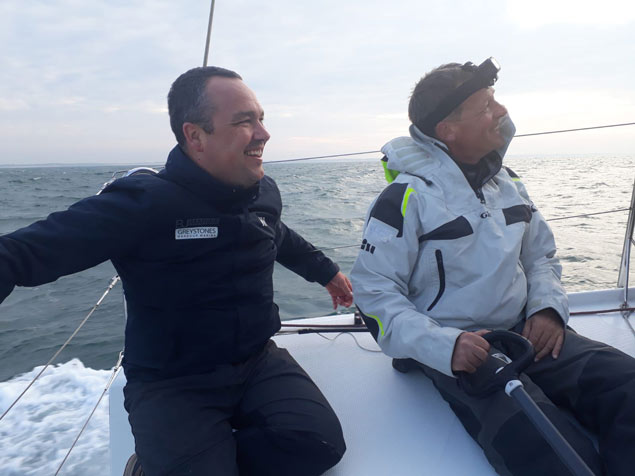 Conor Fogerty (right) on the helm of the foiling keelboat with broker James Kirwan of BJ Marine
Conor Fogerty (right) on the helm of the foiling keelboat with broker James Kirwan of BJ Marine
Howth's Yacht Club Fogerty & Knowles in Wing Position in Round Britain & Ireland Fleet
After the second night at sea in the RORC Sevenstar Round Britain & Ireland Race, the fleet find themselves still slugging to windward in the area west and northwest of the Isles of Scilly writes W M Nixon.
They’re in the frustrating position of knowing that those who can get quickest to southwest Ireland will find more favourable westerly winds. But in the Isles of Scilly area itself, the wind has stayed doggedly in the northwest, and while progress is reasonably good, the prospect of easing sheets and getting to better speeds remains tantalisingly elusive.
Conor Fogerty and Simon Knowles of Howth Yacht Club in the Sunfast 3600 Bam! In the Two-Handed Division found themselves in loose formation with their sister-ships southeast of the Isles of Scilly at 0100 hrs today, with the Sunfast 3600 Game On (Ian Hoddle & Ollie Wyatt) coming in on seaward on port tack and passing five miles ahead of Bam, which had been working to windward further north.
Game On then elected to leave the large Traffic Separation Zone to the south of the Scllies to port, but Bam and sister-ship Tigris (Gavin Howe), which was four miles astern, held on starboard out into open water south of the separation zone in search of the elusive backing of the breeze.
At this morning’s 0800 position fix, Bam was making unspectacular but steady progress at 5.3 knots on a course of 264 degrees, while Tigris was seven miles astern at similar speed and course. Game On in meanwhile well to the northeast with a slightly better breeze to give 5.8 knots, though with little difference in course at 260.
Overall, the fleet leaders on the water continue to be the large Class 40 contingent, with the new Corum (she made her successful debut in the Volvo Round Ireland race in June) skippered by Nicolas Troussel in a battle for line honours with Phil Sharp’s Imerys Clean Energy, When you consider the speeds they’re capable of, their current progress around the 7.7 to 8.5 knot rate is modest enough. But Corum is now the most westerly boat in the fleet, sailing on port tack, and with a course of 323 finally laying the line to take her round the still distant Mizen Head.
Equally, Bam is the most westerly of the smaller boats, and it will be intriguing this morning to see when Fogerty and Knowles call their tack to start making serious progress towards southwest Ireland.
Race tracker here: http://yb.tl/rbni2018
Howth Crew Fogerty & Knowles Battle For Top Two-Handed Place In RB&I
#RB&I - Conor Fogerty and Simon Knowles in the Sunfast 3600 BAM! were yesterday evening narrowly leading the two-handed division in the RORC Sevenstar Round Britain & Ireland’s 1,805-mile marathon, writes W M Nixon.
The Howth Yacht Club duo were trying to keep cover on the Figaro 2 El Velosolex SL Energies Group (Bejamin Schwartz & Chen Jin Hao) close to the north of them, and Sunfast 3600 sister-ship Game On (Ian Hoddle & Ollie Wyatt) to their southeast as the fleet approached the massive tidal gate of Portland Bill, sailing hard on the wind.
El Velsolex to the north found freshening breeze in under Portland Island, which also got her more quickly into the Bill’s beneficial tidal shadow.
With the local sharpening of the breeze, she was able to make a clinical of job of rounding Portland Bill within a stone’s throw of the shore in slacker water, and then lengthening away into Lyme Bay on port tack.
This left BAM! with the least bad option of following, and though she too was right in on the shore at the point itself, the spark had gone from the breeze and for a while she was hung up at only 2.2 knots over the ground.
El Velosolex, meanwhile, got away into a lead of thee miles before the Irish boat got going again, but at least Game On had been left well astern, so much so that she opted to go well offshore.
Any beat westward in the English Channel will find a varying pattern of wind strengths, and through the night as the fleet slowly neared Start Point with the Mach 40.3 Corum (Nicolas Troussel) leading narrowly on the water from Phil Sharp’s Class 40 Imerys Clean Energy, at times those inshore were favoured.
But then those offshore began to get better breezes, and when the group to the north closed with the southerly group off Start Point around 7am this morning, El Velosolex had lengthened further to eight miles ahead of BAM!, but the latter was now neck-and-neck with Game On.
The two Sunfast 3600s — less than two miles apart — elected to continue the offshore tack on starboard, but at 10.29am El Velosolex tacked onto port.
This was the state of affairs at the noon position, with the Figaro still heading for the distant shore, while Game On and BAM! are holding on starboard and having a right dong, Game On ahead by 1.7 sea miles and sailing at 6.3 knots, and Bam! on her weather quarter shown as sailing at 6.4 knots. And they still have 1,670 miles to go.
Crossing the Celtic Sea from the Isles of Scilly to southwest Ireland will be interesting, as the wind is forecast to be bang on the nose at first, but backing through tomorrow. This suggests that keeping to the left will be a strategic imperative, but for how long will be anyone’s guess.
Race Tracker here: http://yb.tl/rbni2018





























